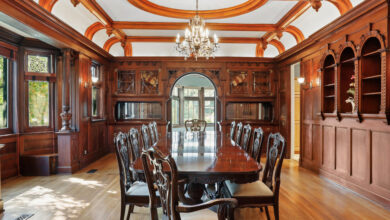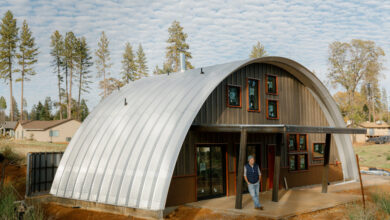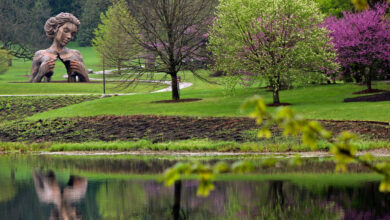Greg Norman Knows About Golf and Golf Homes

[ad_1]
When it comes to golf, Greg Norman is a familiar name. Born in Mount Isa, Australia, the retired professional golfer, 67, is the chief executive of Greg Norman Golf Course Design, a firm that has designed more than 100 courses in 34 countries.
Mr. Norman, who now resides in Palm Beach Gardens, Fla., is also behind residences in more than 17 golf communities globally, including Rancho San Lucas in Cabo San Lucas, Mexico, Pelican Waters in Queensland, Australia, and Reflection by Greg Norman in Ho Chi Minh City, Vietnam.
Golf has gained tremendous popularity in the wake of the pandemic, according to Mr. Norman, and the interest in owning a golf property has increased in the same vein. “Golf takes you outdoors for hours and is an automatically socially distanced sport,” he said. “After years of declining traction, it’s now being rediscovered in new destinations and has seen well-established markets full of activity again.”
Below are edited excerpts from a recent interview with Mr. Norman where he shared his perspective on emerging golf locales and what makes an ideal golf home today.
In your opinion, what are the most up-and-coming destinations today for golf homes?
Saudi Arabia is definitely hot. The kingdom is making a massive investment in tourism, and golf tourism is a big part of this larger initiative. There are 25 golf courses slated to be built in the country by 2030. I’m working on a 27-hole design in Diriyah Gate, a planned mini-city of sorts that’s just outside of Riyadh. It will have shopping, entertainment, housing and much more.
Costa Rica is also emerging and has great golf courses on its Pacific Coast. Some are part of developments with residences, and others aren’t. Either way, there are a lot of golf home options. You have apartments in buildings with lots of amenities, townhouses and villas on the beach. The perk of owning a home here is that you get to enjoy great surfing and fishing and that real estate is inexpensive when you compare it to other places with high-quality golf.
I also can’t leave out the coastline north of Cabo San Lucas, which stretches for hundreds of miles. Cabo itself is saturated with golf courses and properties, but the region has lots of open space with new properties coming up.
Can you talk about the appeal of golf in Vietnam, where you’ve designed seven courses, are working on 10 more and have residential projects?
Similar to Saudi Arabia, the country is investing heavily in golf tourism by building new courses and developments that have residences and golf. There are options all over Vietnam, and each has its own appeal.
Near Ho Chi Minh City, NovaWorld Phan Thiet has two 18-hole championship courses that we designed inside an almost 2,500-acre resort along the coast. The property reminds me a lot of my home country, Australia, with its broad undulations and rugged vegetation. The sandbelt of Australia was the inspiration for the design of our courses there and they fit very naturally with the terrain.
The Bluffs Ho Tram, located southeast of Ho Chi Minh City, is an 18-hole course with 60-meter sand dunes and views of the ocean.
We just started design work on our first course outside of Hanoi. It has a significant amount of topography and dense vegetation, so they are clearing the property now. I’ve designed several courses in high terrain, such as the mountains of Korea and Japan, so I’m looking forward to drawing from that experience to create something different than the coastal region courses we’ve designed in Vietnam.
What are the benefits of buying a golf home in Vietnam?
For starters, it’s an incredibly beautiful country that’s diverse — from its tropical rainforests to the gorgeous coastline to the historical cities. Then there are unbelievably friendly locals and delicious, fresh food. It’s also very safe and has lots of activities including snorkeling, swimming, hiking in the rainforest and boating.
The cities have amazing sightseeing, and from a value point of view, I would put it in the top three destinations in the world. Your money goes a long way in Vietnam. You can find a great three-bedroom property with amenities like a pool in a luxury development or on the beach for less than $500,000.
Tell me about the golf scene in Dubai, where you’ve designed several courses, and are also behind the residences Fireside by Greg Norman. What makes Dubai so appealing?
One of the great things about Dubai is that it’s very centrally located from a global standpoint and the government has done a great job staying ahead of the curve with air travel into the country and infrastructure. Dubai has also done a great job of showcasing its culture, which has played a big part in the growth of tourism in the country.
What makes a golf home destination a strong one?
It depends on what you’re looking for, but you want a place that’s easy to reach. You won’t use the property if it takes all day to get there. You also ideally want to buy in a location that you can enjoy most of the year and has non-golf diversions. You can only play the game so much.
Aspen is an example or Big Sky, Montana. You can ski during the winter, golf most months and also enjoy recreation like hiking and mountain biking. Bodrum, Turkey, is another example because there’s great golf, mild weather year-round and beautiful beaches. Plus, it has good accessibility with lots of flights daily from Istanbul and nonstop flights from other cities in Europe.
In golf markets that are saturated such as South Florida, is it still possible to find an affordable home?
Yes, but you must look outside of areas that are super popular and where inventory is limited. West Palm Beach and Naples are expensive, and it’s hard to find a home at all, let alone an affordable home. The scenario changes if you look north to Martin County. My top tip is to look to secondary markets.
Sustainability in golf course design and golf properties are priorities for you. Can you share sustainable features of both that interested buyers should look for during their search?
With golf courses, look for electric golf carts, using recycled water to irrigate the courses, and avoiding the use of chemicals to care for grass as much as possible. Sustainable courses also don’t rely on plastics in their restaurants and use local food purveyors whenever they can.
Sustainable golf homes should rely on solar energy and be constructed with green materials like pine. And they should have heating and cooling systems that are energy efficient.
Many sustainable features aren’t overly apparent when you’re looking at properties and courses so the only way to know is to do your due diligence.
[ad_2]
Source link






